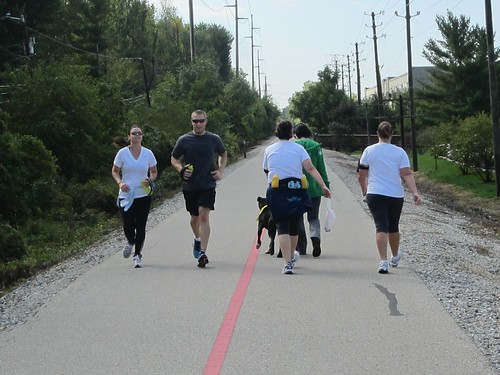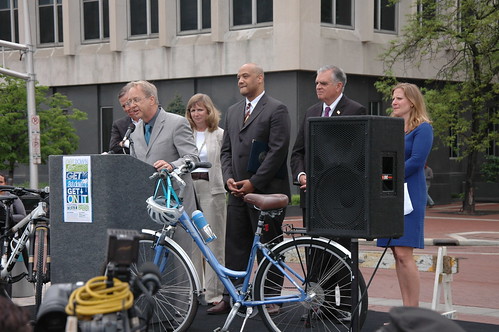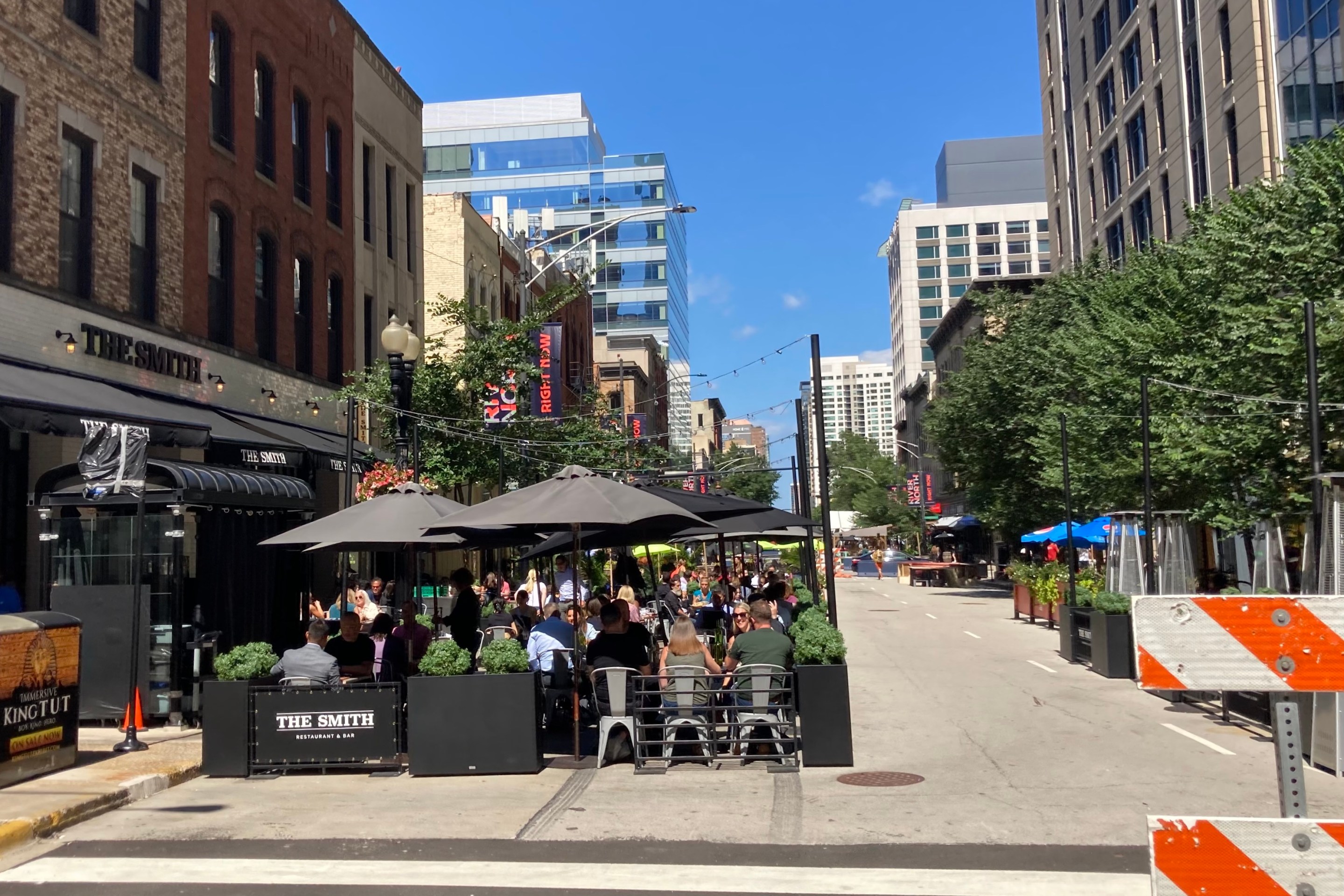NACTO Workshop Visits Indianapolis to Help It Become a Better Cycling City
5:45 PM CDT on May 21, 2013
Guest author Jack Cebe is a planner and designer with Alta Planning + Design in Chicago, a firm dedicated to creating active communities where bicycling and walking are safe, healthy, fun, and normal daily activities.
Last week, I traveled to Indianapolis to attend the National Association of City Transportation Officialsseventh Cities for Cycling Roadshow. The Roadshow gathers leaders in bicycling transportation from the country’s top bicycle-friendly cities to provide technical assistance for cities that have shown a dedication to improving cycling as a transportation option. It includes presentations and discussions with local political leaders, engineers, planners and advocates; and is intended to both offer encouragement and share knowledge with citizens and officials.
The two-day workshop was led by four nationally recognized experts in the design, planning, and advancement of livable communities: David Vega-Barachowitz, sustainable initiatives program manager with NACTO; Nicole Freedman, director of bicycle programs with the city of Boston; Robert Burchfield, city traffic engineer with the Portland Bureau of Transportation; and Mike Amsden, project manager with The Chicago Department of Transportation. Jamison Hutchins, Indianapolis bicycle coordinator, was the head organizer of the event.
On Thursday, the workshop began with a presentation to city government and transportation leaders. Indianapolis has implemented several world-class bicycle facilities and amenities such as the Cultural Trail separated bike lane network, Indy Bike Hub Bike parking centers, an extensive greenway network, and an upcoming bike-share system. The main message was that Indianapolis had already accomplished much of the hard work in striving to become a more bicycle-friendly city; now it's time to go after the “low-hanging fruit” projects that will make the network more complete and encourage more people to ride.
Roadshow leaders identified that this is a pivotal moment for increasing biking in Indianapolis. Under Mayor Greg Ballard the city currently has strong leadership that understands the importance of cycling. While future administrations may not be as supportive of active transportation as current leaders, roadshow leaders offered encouragement by pointing out that it's much easier to prevent transportation progress than to undo it, and if the programs you initiate now are successful, then subsequent leaders will be supportive of them.
Later that day, the Cities for Cycling Roadshow biked to the Indianapolis Department of Public Works for an afternoon workshop. The purpose of this seminar was to educate department planners and engineers on best practices for bicycle facility design, with a focus on advanced facilities and concepts such as cycle tracks, neighborhood greenways (also known as bike boulevards), intersection markings, and bike signalization. The Roadshow was met by a very welcoming and attentive audience. Around 40 staff members were in attendance, many who were asking questions and taking notes throughout the presentations. Lori Miser, director of IDPW and Andy Lutz, deputy director, emphasized throughout the workshop that bicycling accommodation is a priority for the department.
Thursday evening, the public was invited to attend an open discussion session with the roadshow leaders. Topics ranged from equity in active transportation, to the use of technology in bike planning and encouragement, to comparisons between Indianapolis and the represented peer cities. One of the most interesting parts of the discussion was when Freedman, Amsden, and Burchfield were each asked “what direction do you see cycling moving in the next 20 years?” Burchfield noted that Portland’s transportation budget currently meets 20 percent of its outstanding transportation needs. “If this continues to be the case, what are our streets going to start to look like in several years?" he said. "We have to start thinking in creative ways about how our cities will change and transform.”
Some of the changes he discussed included actively discouraging driving (through fees, eliminating parking, etc.), getting more private companies to sponsor transportation projects, and growing raised cycle track networks as city streets are reconstructed. As a follow up to this question, participants were asked what bicycling mode share goals have been set in each of their cities. According to the participants, Portland has a goal of having 25 percent of all trips made by bicycle by 2030 (although Burchfield suggested the city should set intermediate goals as well), Boston has a goal of having 10 percent of all trips made by bicycle by 2020, and Chicago’s goal is five percent of trips by 2015.
Friday morning included a tour of the Indianapolis bicycle network with IDPW staff and roadshow leaders. This tour included critical look at current facilities and the sites of future, planned facilities. Many of the city’s on-street bikeways outside the downtown core are narrow four-to-five-foot bike lanes on large, multilane, under-utilized roadways. The group identified several areas where these bikeways could potentially be widened and converted into cycle tracks by eliminating one of the vehicular travel lanes. The Roadshow also looked at several opportunities for implementing neighborhood greenways and providing improvements for bicyclists at major roadway crossings.
The group took a look at a planned neighborhood greenway on 17th Street through King/Kennedy Park, as well as a difficult trail crossing and proposed cycle track at the intersection of the White River Trail, Central Canal Trail, and 29th Street. Later, Roadshow leaders and Indianapolis officials discussed potential improvements for these problem areas. While it was apparent from the tour that the current on-street bikeway network in Indianapolis is limited in many areas, it was also clear and encouraging that city transportation officials are actively looking into ways to improve these facilities using innovative treatments such as cycle tracks, bike boxes, neighborhood greenways and bike signals.
On Friday afternoon, the dedication and ribbon cutting of the Indianapolis Cultural Trail took place, officially opening up the eight-mile trail for business, inviting citizens and visitors to “get down on it.” As expected, the all-star lineup of city and national leaders expressed strong support for the trail and active transportation, citing the positive economic and health impacts that the trail and projects like it are having on Indianapolis and communities throughout the United States. Along with the familiar rhetoric touting the benefits of active transportation, one quote stood out above the rest. “We are changing the way that pedestrians, bicyclists, and people in wheelchairs experience the city," said Brian Payne, president and CEO of the Central Indiana Community Foundation and the Indianapolis Foundation.
This statement couldn’t be more true. I had seen many people of all walks of life enjoying the trail since I arrived in Indianapolis. The city created an award-winning, one-of-a-kind amenity that serves as both a downtown destination and transportation facility. It connects to the already extensive Indianapolis greenway network and draws residents and visitors to the downtown. Most importantly, it is attractive and accessible to people of all demographics and physical abilities, a key element of successful non-motorized transportation facilities.
The designs, policies and programs emphasized in the Cities for Cycling Roadshow are designed to create bikeway networks that are as successful as the Indianapolis Cultural Trail. These networks don’t just provide transportation options for bold and able-bodied bicyclists, but rather for people of all ages, classes, and backgrounds. Hopefully Indianapolis officials, planners and engineers will continue to keep this in mind as the city moves forward in expanding non-motorized transportation options for its citizens.
Stay in touch
Sign up for our free newsletter
More from Streetsblog Chicago
Today’s Headlines for Friday, April 19
Tasty news: Friedman Properties is trying to break the Clark outdoor dining stalemate by applying for street closure permits
Mayor Johnson's administration and Ald. Reilly haven't yet found common ground on bringing back the popular car-free zone. Will this make the difference?
Roger that! Streetsblog SF editor Roger Rudick offers constructive criticism of Chicago’s downtown bike network
"There were blocks that felt very safe and very secure," he said. "But then you're immediately – voom! – disgorged into three lanes of moving traffic with no protection."







